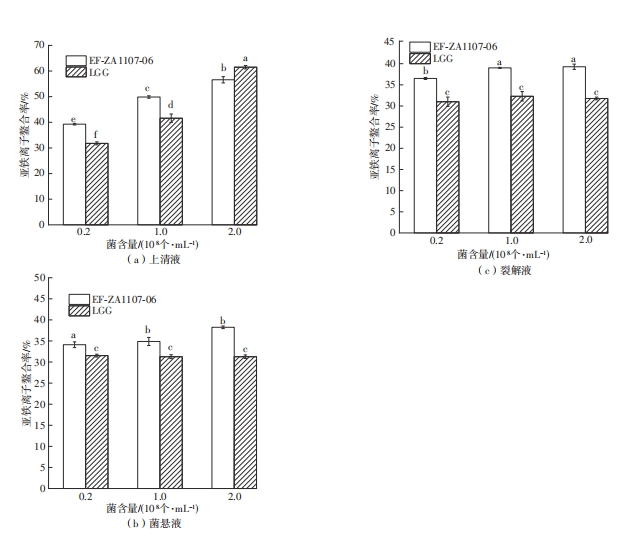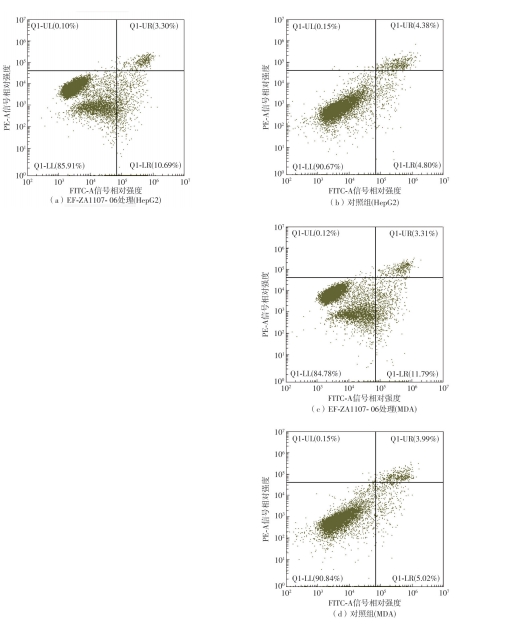Journal of South China University of Technology(Natural Science Edition) ›› 2023, Vol. 51 ›› Issue (12): 118-130.doi: 10.12141/j.issn.1000-565X.220798
• Food Science & Technology • Previous Articles Next Articles
Study on Beneficial Characteristics inVitro of Enterococcus Faecalis EF-ZA1107-06
XU Xilin PENG Yunyan ZHOU Xiaoli ZHONG Shuying DUAN Longhui LIU Dongmei
- School of Food Science and Engineering,South China University of Technology,Guangzhou 510640,Guangdong,China
-
Received:2022-12-05Online:2023-12-25Published:2023-05-06 -
About author:许喜林(1964-),男,博士,副教授,主要从事食品安全与控制研究。E-mail: xuxilin@scut.edu.cn -
Supported by:the National Natural Science Foundation of China(31771908)
CLC Number:
Cite this article
XU Xilin, PENG Yunyan, ZHOU Xiaoli, et al. Study on Beneficial Characteristics inVitro of Enterococcus Faecalis EF-ZA1107-06[J]. Journal of South China University of Technology(Natural Science Edition), 2023, 51(12): 118-130.
share this article
Table 4
Effect of EF-ZA1107-06 on oxidase activity"
| 组别 | GSH-Px酶活/(U·μg-1) | SOD酶活/(U·μg-1) | CAT酶活/(U·μg-1) |
|---|---|---|---|
| 空白组 | 2.15±0.00c | 23.74±1.02a | 26.57±0.41a |
| 损伤组 | 13.62±0.04a | 21.76±0.73b | 9.39±0.29c |
| A1107-06上清液组 | 3.23±0.04c* | 22.83±0.92a* | 14.88±0.31b* |
| LGG上清液组 | 7.71±0.75b* | 23.04±1.02a* | 17.48±0.47b* |
| A1107-06灭活菌体组 | 1.62±0.08c* | 22.46±0.69a* | 15.19±0.50b* |
| LGG灭活菌体组 | 4.31±0.52bc* | 22.36±1.07a* | 11.22±0.25c |
| A1107-06裂解液组 | 4.83±0.52bc* | 22.77±1.30a* | 27.08±0.26a* |
| LGG裂解液组 | 7.53±0.52b* | 23.17±1.35a* | 10.76±0.19c |
| 1 | 刘洋,郭宇星,潘道东 .4种乳酸菌体外抗氧化能力的比较研究[J].食品科学,2012,33(11):25-29. |
| LIU Yang, GUO Yuxing, PANG Daodong .Comparative antioxidant activity of four species of lactic acid bacteria in vitro [J].Food Science,2012,33(11):25-29. | |
| 2 | 赵彤,钟宜科,荀一萍,等 .乳酸菌抗氧化性及其作用机制研究进展[J].中国食品添加剂,2018(9):202-209. |
| ZHAO Tong, ZHONG Yike, XUN Yiping,et al .Research progress on antioxidation and regulation mechanism of lactic acid bacteria[J].China Food Additives,2018(9):202-209. | |
| 3 | HAN W, ZHANG X L, WANG D W,et al .Effects of microencapsulated Enterococcus fecalis CG1.0007 on growth performance,antioxidation activity,and intestinal microbiota in broiler chickens1[J].Journal of Animal Science,2013,91(9):4374-4382. |
| 4 | 刘长建,刘秋,姜波,等 .鹑鸡肠球菌m661的抗氧化、降胆固醇作用[J].食品科学,2013,34(7):157-161. |
| LIU Changjian, LIU Qiu, JIANG Bo,et al .Antioxidant and cholesterol-reducing properties of Enterococcus gallinarum m661[J].Food Science,2013,34(7):157-161. | |
| 5 | 董翎逸,刘正奇,裘梁,等 .屎肠球菌WEFA23和海氏肠球菌WEHI01发酵荷叶上清的抑菌及抗氧化评价[J].南昌大学学报(理科版),2018,42(4):73-79. |
| DONG Lingyi, LIU Zhengqi, QIU Liang,et al .Antibacterial and antioxidant evaluation of supernatant of the fermented lotus leaf by Enterococcus faecium WETA23 and Enterococci hirae WHEHL01[J].Journal of Nanchang University (Natural Science),2018,42(4):73-79. | |
| 6 | FRANZ C, STILES M E, SCHLEIGER K H,et al . Enterococci in foods-a conundrum for food safety[J].International Journal of Food Microbiology,2003,88(23):105-122. |
| 7 | WOO J Y, GU W, KIM K A,et al . Lactobacillus pentosus var. plantarum C29 ameliorates memory impairment and inflammaging in a D-galactose-induced accelerated aging mouse model [J].Anaerobe,2014,27:22-26. |
| 8 | THIRABUNYANON M, BOONPRASOM P, NIAMSUP P .Probiotic potential of lactic acid bacteria isolated from fermented dairy milks on antiproliferation of colon cancer cells[J].Biotechnology Letters,2009,31(4):571-576. |
| 9 | CHOUDHURI I, KHANRA K, PARIVA P,et al .Structural characterization of an exopolysaccharide isolated from Enterococcus faecalis,and study on its antioxidant activity,and cytotoxicity against HeLa cells[J].Current Microbiology,2020,77(10):3125-3135. |
| 10 | AMER M N, MANSOUR N M, El-DIWANY A I,et al .Isolation of probiotic Lactobacilli strains harboring L-asparaginase and arginine deiminase genes from human infant feces for their potential application in cancer prevention[J].Annls of Microbiology,2013,63(3):1121-1129. |
| 11 | WANG Y, WATERS J, LEUNG M L,et al .Clonal evolution in breast cancer revealed by single nucleus genome sequencing[J].Nature,2014,512(7513):155-160. |
| 12 | RAWLA P, SUNKARA T, BARSOUK A. Epidemiology of colorectal cancer:incidence,mortality,survival,and risk factors[J].Przeglad Gastroenterologiczny,2019,14(2):89-103. |
| 13 | UCCELLO M, MALAGUARNERA G, BASILE F,et al .Potential role of probiotics on colorectal cancer prevention[J].BMC Surgery,2012,12:S35/1-8. |
| 14 | CASTRO M S, MOLINA M A, SCIULLO P D,et al .Beneficial activity of Enterococcus faecalis CECT7121 in the anti-lymphoma protective response[J].Journal of Applied Microbiology,2010,109(4):1234-1243. |
| 15 | PANWAR H, CALDERWOOD D, GRANT I R,et al . Lactobacillus strains isolated from infant faeces possess potent inhibitory activity against intestinal alpha-and beta-glucosidases suggesting antidiabetic potential[J].European Journal of Nutrition,2014,53(7):1465-1474. |
| 16 | 周晓莉 .粪肠球菌EF-ZA1107-06的益生性及高密度培养的研究[D].广州:华南理工大学,2021. |
| 17 | YADAV H, JAIN S, SINHA P R .Antidiabetic effect of probiotic dahi containing Lactobacillus acidophilus and Lactobacillus casei in high fructose fed rats[J].Nutrition,2007,23(1):62-68. |
| 18 | 刘顺,谢远红,张红星,等 .具有潜在降血糖作用乳酸菌的筛选[J].食品工业科技,2019,40(16):255-259,273. |
| LIU Shun, XIE Yuanhong, ZHANG Hongxing,et al .Screening of lactic acid bacteria with potential hypoglycemic effect[J].Science and Technology of Food Industry,2019,40(16):255-259,273. | |
| 19 | 孙明雪,邹纯才,鄢海燕 .瓜蒌提取物抗氧化药效成分群的筛选与验证[J].南方医科大学学报,2022,42(3):384-391. |
| SUN Mingxue, ZOU Chuncai, YAN Haiyan .Screening of effective antioxidant components from Trichosanthes extract and assessment of their antioxidant activity[J].Journal of Southern Medical University,2022,42(3):384-391. | |
| 20 | 束文秀,吴祖芳,翁佩芳,等 .植物乳杆菌和发酵乳杆菌对胡柚汁发酵品质及其抗氧化性的影响[J].食品科学,2019,40(2):152-158. |
| SHU Wenxiu, WU Zufang, WENG Peifang,et al .Comparison of quality characteristics and antioxidant activity of the fruit juice of Citrus paradisi cv.changshan huyou fermented by Lactobacillus plantarum and Lactobacillus fermentym [J].Food Science,2019,40(2):152-158. | |
| 21 | LIN M Y, YEN C L .Antioxidative ability of lactic acid bacteria[J].Journal of Agricultural and Food Chemistry,1999,47(4):1460-1466. |
| 22 | DAS D, GOYAL A .Antioxidant activity and γ-aminobutyric acid (GABA) producing ability of probiotic Lactobacillus plantarum DM5 isolated from Marcha of Sikkim[J].LWT-Food Science and Technology,2015,61(1):263-268. |
| 23 | KULLISAAR T, ZILMER M, MIKELSAAR M,et al .Two antioxidative lactobacilli strains as promising probiotics[J].International Journal of Food Microbiology,2002,72(3):215-224. |
| 24 | 刘少敏 .不同乳酸菌抗氧化能力比较及其机制的研究[D].哈尔滨:东北农业大学,2015. |
| 25 | SHEN W, SONG D, WU J,et al .Protective effect of a polysaccharide isolated from a cultivated Cordyceps mycelia on hydrogen peroxide-induced oxidative damage in PC12 cells[J].Phytotherapy Research,2011,25(5):675-680. |
| 26 | 张园莲 .抑制结直肠癌细胞HT-29增殖的益生菌筛选及其作用机理研究[D].昆明:昆明理工大学,2018. |
| 27 | 王淑梅 .抗结肠癌功能益生菌筛选及其诱导HT-29细胞凋亡机制研究[D].哈尔滨:哈尔滨工业大学,2014. |
| 28 | ZHANG J F, ZHENG Y G, SHEN Y C .Inhibitory effect of valienamine on the enzymatic activity of honeybee (Apis cerana Fabr.) α-glucosidase[J].Pesticide Biochemistry & Physiology,2007,87(1):73-77. |
| 29 | ZENG Z, LUO J Y, ZUO F,et al .Screening for potential novel probiotic Lactobacillus strains based on high dipeptidyl peptidase IV and α-glucosidase inhibitory activity[J].Journal of Functional Foods,2016,20:486-495. |
| 30 | 龙楚媚,付强,王琪,等 .罗汉果内生菌的分离及α-淀粉酶抑制剂产生菌的筛选[J].中国酿造,2019,38(1):71-74. |
| LONG Chumei, FU Qiang, WANG Qi,et al .Isolation of endophytes from Siraitia grosvenorii and screening of α-amylase inhibitors-producing strains [J].China Brewing,2019,38(1):71-74. | |
| 31 | RAMCHANDRAN L, SHAH N P .Effect of exopolysaccharides and inulin on the proteolytic,angiotensin-I-converting enzyme- and α-glucosidase-inhibitory activities as well as on textural and rheological properties of low-fat yogurt during refrigerated storage[J].Dairy Science & Technology,2009,89(6):583-600. |
| 32 | 张江巍,曹郁生,李海星,等 .乳酸菌抗氧化活性及检测方法[J].中国乳品工业,2005,33(9):53-55. |
| ZHANG Jiangwei, CAO Yusheng, LI Haixing,et al .Antioxidative activities of lactic acid bacteria and the test method[J].China Dairy Industry,2005,33(9):53-55. | |
| 33 | 巩蕾,都启晶,赵宏坤 .屎肠球菌JT_1的抗氧化特性[J].食品科技,2017,42(6):30-35. |
| GONG Lei, DU Qijing, ZHAO Hongkun .The oxidation resistance of Enterococcus faecium JT1[J].Food Science and Technology,2017,42(6):30-35. | |
| 34 | 郭慧芬 .发酵肉制品中抗氧化乳酸菌的筛选及其特性的初步研究[D].呼和浩特:内蒙古农业大学,2017. |
| 35 | HUANG G J, CHEN H J, CHANG Y S,et al .Recombinant sporamin and its synthesized peptides with antioxidant activities in vitro [J].Botanical Studies,2007,48(2):133-140. |
| 36 | 吴贝,张盼望,王喜亮,等 .益生屎肠球菌HDRsEf1抗氧化性能评估[J].华中农业大学学报,2016,35(6):98-103. |
| WU Bei, ZHANG Panwang, WANG Xiliang,et al .Antioxidant performance evaluation of Enterococcus faecium HDRsEf1[J].Journal of Huazhong Agricultural University,2016,35(6):98-103. | |
| 37 | 张书文 .抗氧化乳酸菌的筛选及其特性研究[D].呼和浩特:内蒙古农业大学,2009. |
| 38 | 陈佩,党辉 .干酪乳杆菌对HepG2细胞抗氧化功能的影响[J].食品科学,2017,38(11):220-224. |
| CHEN Pei, DANG Hui .Effect of Lactobacillus casei on antioxidant function of HepG2 cells[J].Food Science,2017,38(11):220-224. | |
| 39 | LIN M Y, CHANG F J .Antioxidative effect of intestinal bacteria Bifidobacterium longum ATCC 15708 and Lactobacillus acidophilus ATCC 4356[J].Digestive Diseases & Sciences,2000,45(8):1617-1622. |
| 40 | 崔志文,黄琴,黄怡,等 .鼠李糖乳酸杆菌对Caco-2细胞抗氧化功能的影响[J].中国农业科学,2011,44(23):4926-4932. |
| CUI Zhiwen, HUANG Qin, HUANG Yi,et al .Antioxidative function of Lacbacillus rhamnosus to Caco-2 cells[J].Scientia Agricultura Sinica,2011,44(23):4926-4932. | |
| 41 | HASSAN Z, MUSTAFA S, RAHIM R A,et al .Anti-breast cancer effects of live,heat-killed and cytoplasmic fractions of Enterococcus faecalis and Staphylococcus hominis isolated from human breast milk[J].In Vitro Cellular & Developmental Biology-Animal,2016,52(3):337-348. |
| [1] | XU Xilin, ZHONG Shuying, ZHOU Xiaoli, et al. Safety Evaluation and Probiotic Characteristics of Enterococcus faecalis EF-ZA1107-06 [J]. Journal of South China University of Technology(Natural Science Edition), 2022, 50(11): 52-61. |
| Viewed | ||||||
|
Full text |
|
|||||
|
Abstract |
|
|||||



















